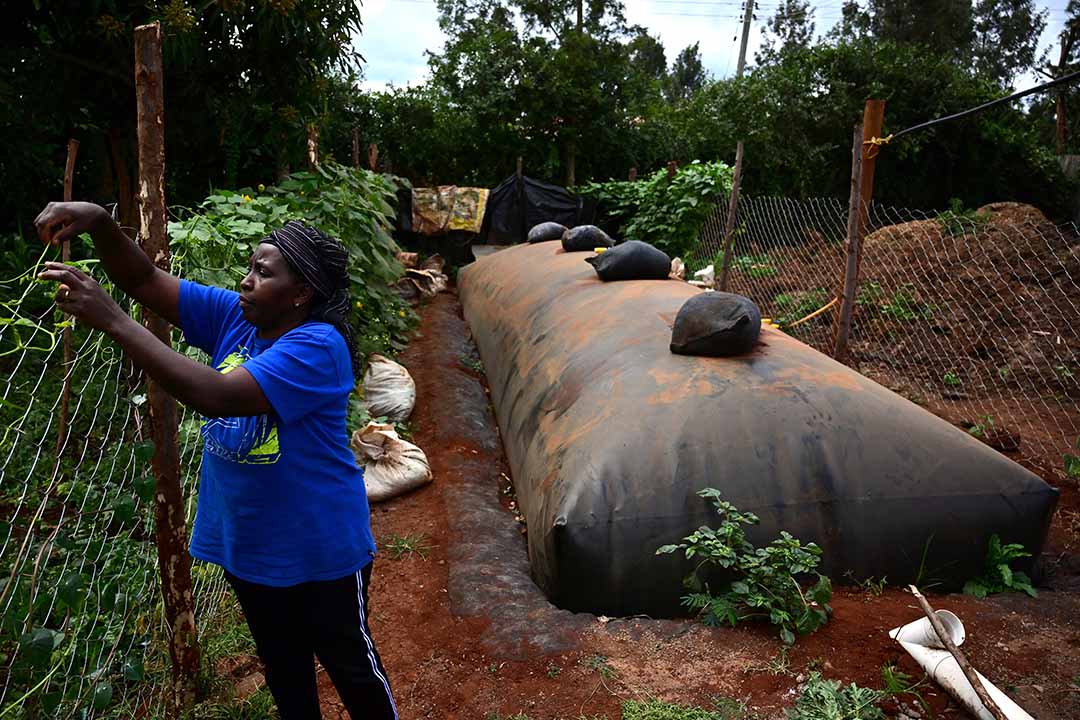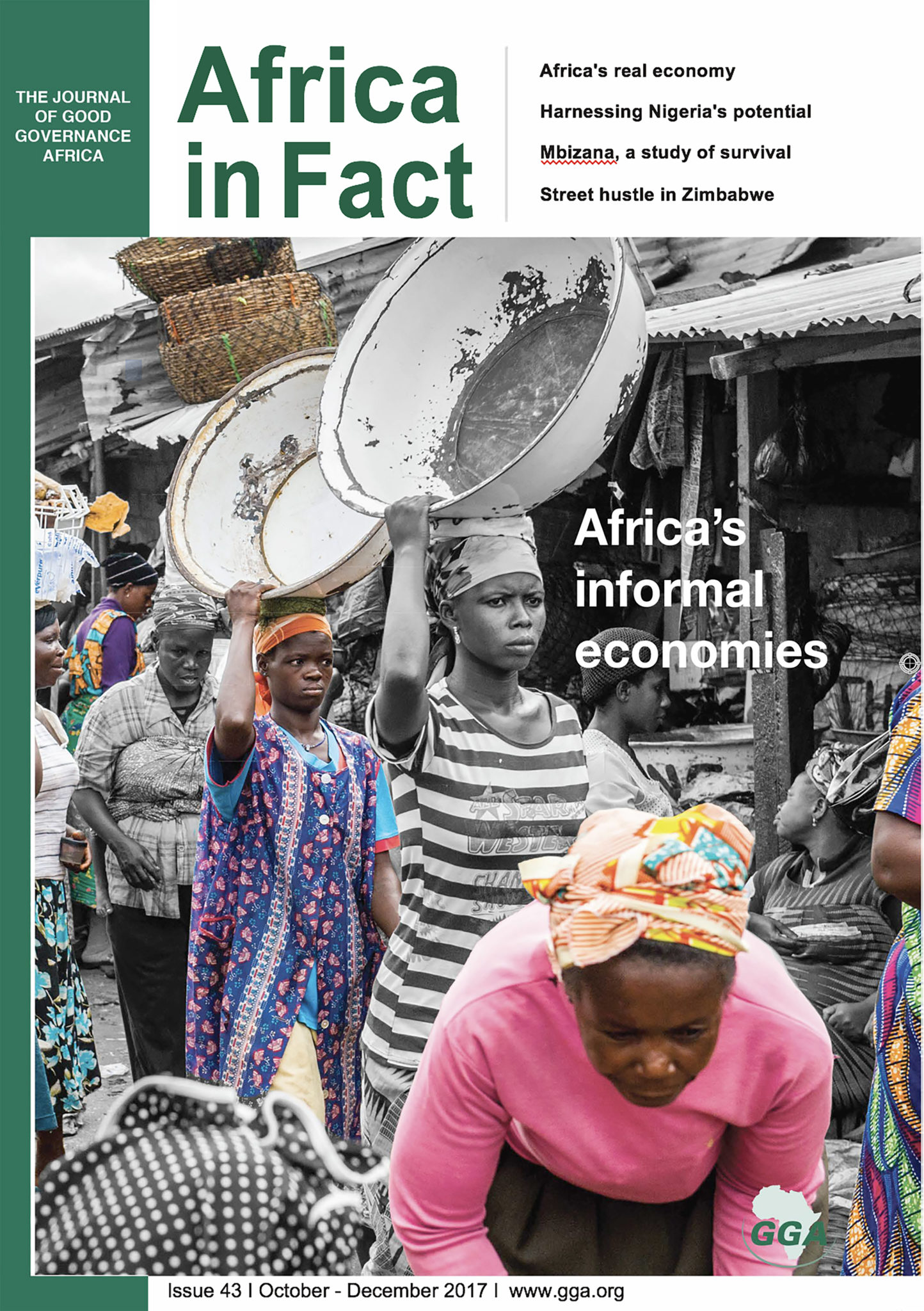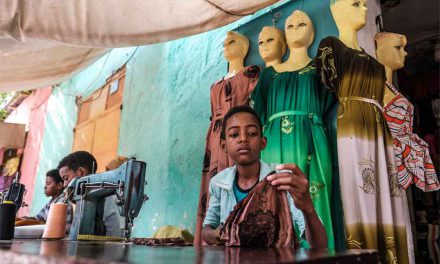Encouraging more sub-Saharan smallholders to farm a mix of food, animals and trees offers an effective way to boost food security and livelihoods.
On a tour of farmlands in many parts of sub-Saharan Africa, especially in the rural areas, you are likely to see green lands with food crops, trees and shrubs. In some instances, the trees may be planted in contour lines interspersed with crops on a piece of land, while in other cases crops are interspersed with shrubs on the same piece of land. This activity, known as agroforestry, has been proposed by environmentalists and conservationists on a tour of farmlands in many parts of sub-Saharan Africa, especially in the rural areas, as an effective way to prevent soil erosion as well as boost food security and increase farm income.

Anne Mburu looks at vegetables that she enriches using slurry that runs off the adjacent flexibag biogas digester installed at her farm in Kiambu, Kenya, in 2019. Photo: Tony Karumba / AFP
For farmers practising agroforestry, their farms are a one-stop shop of products for subsistence as well as a source of income. For instance, farmers cultivate tree products such as fruits, fuel wood, and fodder from their farms. Fodder products boost the growth and milk production of dairy animals such as cows and goats. Farmers in West Africa’s semi-arid areas have adopted multipurpose trees on land popularly known as agroforestry parklands. In 1999, the UN Food and Agricultural Organization (FAO) recognised “their significance as a rich pool of forest genetic diversity” in its report, Agroforestry parklands in sub-Saharan Africa.
But while agroforestry systems promise significant benefits to smallholder farmers, the extent of their socio-economic benefits is still unclear. A study published in the journal World Development in January this year attempted to analyse the downstream socio-economic impacts of agroforestry in Kenya. The study looked at 60 villages practising agroforestry in western Kenya under a Swedish programme, Vi Agroforestry, and 61 villages that were not practising it. Researchers found that smallholder farmers who practised agroforestry, planting trees and shrubs on their farmlands, increased their revenue by almost $50 per person annually.
The researchers said that “despite evidence of variable programme exposure and agroforestry uptake, we found modest, yet statistically significant, effects of Vi Agroforestry’s programme on intermediate outcomes, such as agroforestry product income, fuel wood access, and milk yields among dairy farmers”. The programme was also found to modestly increase asset holdings, especially among female- headed households. However, the study also revealed that the uptake in agroforestry was not as significant as expected. The $50 revenue increase, the study noted, did not represent “a huge, transformative impact, but it should not be entirely dismissed either”.
The limited uptake of agroforestry might be due to a number of factors, including that “farmers simply do not find such innovations particularly useful and cost-effective.” Farmers were unlikely to adopt tree species that might not yield high financial returns, according to a 2016 study of Ethiopian farmers by Geremew Worku Kassie in the journal Cogent Food & Agriculture. The Ethiopian farmers preferred to grow eucalyptus trees because of the saleable products they yielded, such as timber. They used the revenue to “purchase improved farm technologies”, while “the revenue generated from selling tree products could [also] help them to bridge rural financial market failures.”
However, agroforestry is a major method of land use in sub-Saharan Africa, although it is not as widespread as in other regions of the world, such as central America. A study by the World Agroforestry Centre in 2014 mapped the extent of trees on farms in sub-Saharan Africa using satellite imagery and geo- datasets and found that agroforestry amounted to nearly 30% of agricultural land, accommodating 70 million people.

Dina Kapiza, an agro-dealer trained in soil testing, shows the fertiliser in her shop which is most suitable for the soils in Mponela area, Malawi, 2016 Photo: Amos Gumulira / AFP
Priscilla Wainaina, an agricultural economist at the centre, says that this might be “significantly underestimated due to technical limitations in using satellite imagery to identify low-density tree cover common in agroforestry systems” and because agroforestry occurs in areas not officially defined as cropland. However, she notes that the adoption of agroforestry is still relatively limited in low-income countries. Silvopastoral systems – agroforestry that combines trees, fodder and animal grazing in a complementary way – and shade-grown commodity agroforestry systems such as coffee and cocoa – often meet the formal definition of forests, and might not be captured in satellite imagery.
Agroforestry is widespread practice in sub-Saharan Africa, with Ethiopia, Ghana, Guinea, Ivory Coast, Liberia, Uganda and Tanzania leading the field, according to Wainaina. Despite this, however, agroforestry’s potential in sub-Saharan Africa also faces challenges. Results of a study conducted in Rwanda by researchers from the Department of Sustainable Development at Yeungnam University in South Korea and published in the Journal of Forest Science and Technology in November 2017, revealed that despite a government programme and deliberate efforts to promote agroforestry as a way to reduce pressure on the country’s forests, many farmers in the rural areas were not adopting it “due to lack of skills and technical know-how, capital and quality seeds”.
Respondents in Nyamagabe district, where the study took place, told researchers that agroforestry would be boosted by subsidies to farmers, regular training and informal education, the establishment of tree nurseries to improve the production of quality seeds, and by engaging with farmers in decision-making. Effective incentives, says Wainaina, would encourage farmers to widely adopt agroforestry. She proposes a well- defined land tenure system, including the registration of land rights, especially the customary land rights that are common within sub-Saharan Africa agricultural areas. “Recognition of these customary land rights is essential in addressing insecure tenure in most of sub-Saharan Africa,” she says.
“Customary land rights are typically not written into law but are rather rights that are recognised by the local community.” Importantly, she says that customary tenure principles grant all bona fide members of the local community land as a social right. The introduction of individual, statutorily recognised rights can have the effect of dissolving long-standing customary rights, making poorer community members particularly vulnerable. It is important, therefore, she says, that existing customary rights are extended statutory recognition with a legal status equal to private and state land.
There is also a need to strengthen linkages and collaboration among researchers, extension officers and smallholder farmers. Projects intending to promote agroforestry should make this a prerequisite, says Wainaina. Examples include projects underwritten by the UN Framework Convention on Climate Change’s Green Climate Fund, which require all the stakeholders to work together from the conception of the idea, to implementation and completion. This ensures that farmers get up to date information regularly, she says. The growth and adoption of agro- forestry will also be boosted by nature- based enterprises.
This calls for the value-addition of tree products such as honey, shea butter, gum as well as connecting smallholder farmers to well- defined markets. “This would incentivise farmers to adopt agroforestry practices, since they are more likely to engage when they can derive direct benefits,” says Wainaina. Tree seedling production should also be promoted as an enterprise in itself, which would lead to the provision of high-quality seedlings, as well as jobs. This would require regular training for people producing and distributing seedlings. Cash-based incentives such as the UN’s REDD+ programme, which works at reducing emissions from deforestation and forest degradation, could also help by addressing the liquidity constraints smallholder farmers face.
The programme involves compensating farmers (in cash) in exchange for carbon sequestered by the trees. Projects such as the UN REDD+ programme have been piloted in some agroforestry systems in sub-Saharan Africa, in Tanzania for example. Programmes such as these demonstrate the potential for tree commodities such as cocoa and coffee, which are largely produced within agroforestry systems in sub-Saharan Africa, specifically in Ethiopia, Ghana and Ivory Coast, says Wainaina.
Gilbert Nakweya is a journalist from Kenya interested in covering scientific issues with a bias towards the developing world. Topics of interest include health, conservation, agriculture, environment, technology, innovation and higher education.












